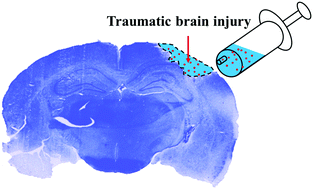Potential application of an injectable hydrogel scaffold loaded with mesenchymal stem cells for treating traumatic brain injury
Abstract
In the past few decades, there have been potential applications for stem cell replacement therapy in the treatment of nervous system damage resulting from diseases or traumatic brain injury (TBI). However, the insufficient number of transplanted stem cells and low survival rate caused by a series of negative conditions limit the therapeutic effect. In this contribution, we developed an injectable hydrogel composed of sodium alginate (SA) and hyaluronic acid (HA) as a tissue scaffold to create a more optimal microenvironment for stem cells after implantation. The gelation time of the HA/SA hydrogel exceeded 6 min, which satisfied the requirements for injection performance, and the high ratios of water content and slower degradation speed affirmed that the HA/SA hydrogel is a preferable stem cell scaffold. As a tissue engineering scaffold, the HA/SA hydrogel exhibited appropriately porous structures for stem cell loading and good rheological behavior, which contributed to stem cell differentiation. The in vitro culture experiment proved that the HA/SA scaffold performed well on hUC-MSCs with higher viability ratio and proliferation. Further in vivo tests indicated that the HA/SA scaffold not only protected the injected human umbilical cord mesenchymal stem cells (hUC-MSCs) so that they could maintain a higher survival ratio, but it also contributed to the regeneration of endogenous nerve cells. In summary, this injectable HA/SA hydrogel has the potential to be used for stem cell tissue engineering and support the physiological function recovery of TBI patients.

- This article is part of the themed collection: Editor’s Choice: Scaffold Engineering


 Please wait while we load your content...
Please wait while we load your content...